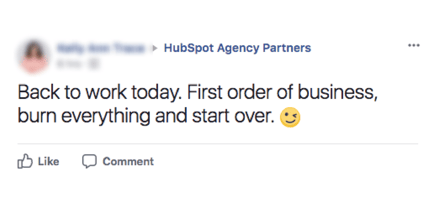Marketing Lessons from HubSpot’s INBOUND 2017

Posted By Sarah Mees on October 05, 2017
It’s been a week since HubSpot’s annual INBOUND Conference, and we’re still reeling from all that we learned about the state of digital marketing in 2017. At the highest level, the way we search today has changed, the way search engines serve up results has changed, so therefore, our approach to SEO has to change too.
At more than one session, attendees were told that keyword ranking is an outdated concept. Search engine results pages (SERPs) are no longer predictable because of the sheer number of available inputs (e.g. factors like location, time of day, device type, and other contextual clues), and because search engines now deliver different types of results (think localized results, featured snippets, the knowledge graph, advertisements, shopping results, etc., etc.). The familiar concept of querying a search engine, much like a database, and getting back 10 blue links...is dead.

So, what does this mean for marketers? Well, it’s complicated. If what you are currently doing is working, keep at it. If what you are currently doing is NOT working, try to diagnose the root of the problem and start trying new things until something works. The other consistent theme of the sessions boils down to “execute, evaluate, evolve.”
In response to all these changes, HubSpot is changing its recommended approach to inbound marketing and updating its products accordingly. Here’s a quick overview of the new HubSpot Content Strategy, which launched in early September.
Optimize your content for search engines.
At first glance, this sounds like the same old strategy—until you factor in all the changes to the search landscape. While generating leads is still the name of the game, the big prize for digital marketers is authority, and that means you have to build your site’s authority before the leads will come pouring in.
Shift your focus from keywords to topics.
Building authority still includes using keywords, but it also includes designing your site and delivering content in a way that the search engines prefer. HubSpot encourages marketers to build sites using topics, or Content Pillars, that is comprised of your most influential content supported by related topics - HubSpot calls them Clusters.
Plan it out.
This starts with evaluating if this approach is even right for your content. Does the topic you want to rank for have enough search volume to be worth making these changes? Do you have enough content to cover the topic, is it something you want to cover in detail? Assuming the answers are yes, then you can start mapping out your pillar and cluster content.
Measure and optimize. Repeat.
The HubSpot Content Strategy tool includes the ability to directly measure each topic cluster’s influence on generating traffic, contacts, and customers, but you don’t have to be using HubSpot. Basic measurement questions include:
- Which topics perform better at driving traffic to your web properties?
- Which topics earn you the most leads?
- Which topics earn the most backlinks/coverage?
Ultimately HubSpot reminds us that “Search Engines Aren’t Searching for Your Content, People Are.” For marketers, the takeaway is that we need to build content that people actually want to see. We want to ‘own’ topics, which means valuing influential content over content volume. Today, less is actually more—if the content is strong and deep.


